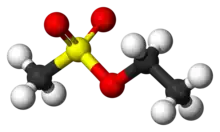 | |
 | |
| Names | |
|---|---|
| Preferred IUPAC name
Ethyl methanesulfonate | |
| Other names
Ethyl mesylate Ethyl methanesulphonate | |
| Identifiers | |
3D model (JSmol) |
|
| Abbreviations | EMS |
| ChEBI | |
| ChEMBL | |
| ChemSpider | |
| ECHA InfoCard | 100.000.488 |
| EC Number |
|
| KEGG | |
PubChem CID |
|
| UNII | |
CompTox Dashboard (EPA) |
|
| |
| |
| Properties | |
| CH3SO3C2H5 | |
| Molar mass | 124.16 g/mol |
| Appearance | Clear colorless liquid |
| Density | 1.1452 g/cm3 (22 °C) |
| Melting point | < 25 °C |
| Boiling point | 85–86 °C (185–187 °F; 358–359 K) /10 mmHg(lit) |
| Vapor pressure | 0.044 kPa @ 25˚C[2] |
| Hazards | |
| GHS labelling:[3] | |
  | |
| Danger | |
| H302, H340, H351 | |
| P203, P264, P270, P280, P301+P317, P318, P330, P405, P501 | |
| NFPA 704 (fire diamond) | |
Except where otherwise noted, data are given for materials in their standard state (at 25 °C [77 °F], 100 kPa).
Infobox references | |
Ethyl methanesulfonate (EMS) is a mutagenic, teratogenic, and carcinogenic organic compound with formula C3H8SO3. It produces random mutations in genetic material by nucleotide substitution; particularly through G:C to A:T transitions induced by guanine alkylation.[4] EMS typically produces only point mutations. Due to its potency and well understood mutational spectrum, EMS is the most commonly used chemical mutagen in experimental genetics.[5] Mutations induced by EMS exposure can then be studied in genetic screens or other assays.
Use in biological research
EMS can induce mutations at a rate of 5x10−4 to 5x10−2 per gene without substantial killing. A 5x10−4 per gene mutation rate observed in a typical EMS mutagenesis experiment of the model organism C. elegans, corresponds to a raw mutation rate of ~7x10−6 mutations per G/C base pair, or about 250 mutations within an originally mutagenized gamete (containing a ~100 Mbp, 36% GC haploid genome).[6] Such a mutagenized gamete would have about 9 different loss-of-function mutations in genes, with 1 to 2 of these mutations being within essential genes and therefore lethal. However, since it is unlikely the same essential gene is mutated in independent gametes, and if loss of the essential gene did not kill the gamete itself, downstream gamete fusion often allows for survival of the resulting zygote and organism, as the now heterozygous non-functional mutated allele may be rescued by the still wildtype allele provided by the other gamete.[6]
Mechanism of mutagenesis
The ethyl group of EMS reacts with guanine in DNA, forming the abnormal base O6-ethylguanine. During DNA replication, DNA polymerases that catalyze the process frequently place thymine, instead of cytosine, opposite O6-ethylguanine. Following subsequent rounds of replication, the original G:C base pair can become an A:T pair (a transition mutation). This changes the genetic information, is often harmful to cells, and can result in disease. RNA polymerase can also place uridine (RNA analog of thymine) opposite an O6-ethylguanine lesion.[7]
Repair of mutagenic lesion
O6-ethylguanine can be repaired in vivo in a stoichiometric fashion by reacting with the active site cysteine of the O-6-methylguanine-DNA methyltransferase repair protein.[8] The in vivo half-life of O6-ethylguanine was reported to be about 9 days in mouse brain, while it was about 1 day in mouse liver.[9]
Induction of recombination
EMS induces mitotic recombination in Saccharomyces cerevisiae.[10] It was suggested that EMS damage to DNA may result in a repair process leading to genetic exchange.[10]
Bacteriophage T4 mutants defective in any one of six genes known to be required for genetic recombination were found to be more sensitive to inactivation by EMS than wild type bacteriophage.[11] This finding suggests that a recombination process catalyzed by the proteins specified by these six genes is employed in repairing EMS lethal lesions in DNA.[11]
Stability
Generally speaking EMS is unstable in water, and undergoes hydrolysis to ethanol and methanesulfonic acid, however at neutral to acidic pH at room temperature, it has a fairly long half-life of over 1 day.[12][13] Therefore, EMS must be specifically degraded before disposal. Protocols call for degradation of EMS in an equal volume of a 0.1M NaOH and 20% w/v sodium thiosulfate "inactivating solution", for at least six half-lives (>24 hours).[6] The half-life of EMS in 1M NaOH is 6 hours at room temperature, while in a 10% w/v sodium thiosulfate solution it has a half-life of 1.4 hours.[13]
See also
References
- ↑ Merck Index, 11th Edition, 3782.
- ↑ "Ethyl Methanesulfonate" (PDF). Report on Carcinogens, Fourteenth Edition. NIEHS. Retrieved 18 June 2021.
- ↑ "Ethyl methanesulfonate". pubchem.ncbi.nlm.nih.gov.
- ↑ Sega, Gary A. (1984). "A review of the genetic effects of ethyl methanesulfonate". Mutation Research/Reviews in Genetic Toxicology. Elsevier BV. 134 (2–3): 113–142. doi:10.1016/0165-1110(84)90007-1. ISSN 0165-1110. PMID 6390190.
- ↑ Kutscher, Lena M.; Shaham, Shai (2014). "Forward and reverse mutagenesis in C. elegans". WormBook: The Online Review of C. Elegans Biology. WormBook: 1–26. doi:10.1895/wormbook.1.167.1. PMC 4078664. PMID 24449699. Retrieved 18 June 2021.
- 1 2 3 Anderson, Philip (1995). "Chapter 2 Mutagenesis". Caenorhabditis elegans: Modern Biological Analysis of an Organism. Methods in Cell Biology. Vol. 48. Elsevier. pp. 31–58. doi:10.1016/s0091-679x(08)61382-5. ISBN 978-0-12-564149-4. ISSN 0091-679X.
- ↑ Gerchman, Lois L.; Ludlum, David B. (1973). "The properties of in templates for RNA polymerase". Biochimica et Biophysica Acta (BBA) - Nucleic Acids and Protein Synthesis. Elsevier BV. 308 (2): 310–316. doi:10.1016/0005-2787(73)90160-3. ISSN 0005-2787. PMID 4706005.
- ↑ Pegg, Anthony E (2000). "Repair of O6-alkylguanine by alkyltransferases". Mutation Research/Reviews in Mutation Research. Elsevier BV. 462 (2–3): 83–100. doi:10.1016/s1383-5742(00)00017-x. ISSN 1383-5742. PMID 10767620.
- ↑ Goth, R.; Rajewsky, M. F. (1974-03-01). "Persistence of O6-Ethylguanine in Rat-Brain DNA: Correlation with Nervous System-Specific Carcinogenesis by Ethylnitrosourea". Proceedings of the National Academy of Sciences. 71 (3): 639–643. Bibcode:1974PNAS...71..639G. doi:10.1073/pnas.71.3.639. ISSN 0027-8424. PMC 388067. PMID 4522778.
- 1 2 Yost Jr, H. T.; Chaleff, R. S.; Finerty, J. P. (1967). "Induction of mitotic recombination in Saccharomyces cerevisiae by ethyl methane sulphonate". Nature. 215 (5101): 660–661. Bibcode:1967Natur.215..660Y. doi:10.1038/215660a0. PMID 6050236. S2CID 1982778.
- 1 2 Johns, V.; Bernstein, C.; Bernstein, H. (1978). "Recombinational repair of alkylation lesions in phage T4. II. Ethyl methanesulfonate". Molecular & General Genetics. 167 (2): 197–207. doi:10.1007/BF00266913. PMID 215891. S2CID 30597383.
- ↑ FROESE-GERTZEN, EDITH E.; KONZAK, C. F.; FOSTER, R.; NILAN, R. A. (1963). "Correlation between Some Chemical and Biological Reactions of Ethyl Methanesulphonate". Nature. Springer Science and Business Media LLC. 198 (4879): 447–448. Bibcode:1963Natur.198..447F. doi:10.1038/198447a0. ISSN 0028-0836. S2CID 12359460.
- 1 2 Kodym, Andrea; Afza, Rownak (2003). "Chapter 12 Physical and Chemical Mutagenesis". Plant functional genomics. Totowa, N.J: Humana Press. pp. 189–203. ISBN 978-1-58829-145-5. OCLC 51445955.
